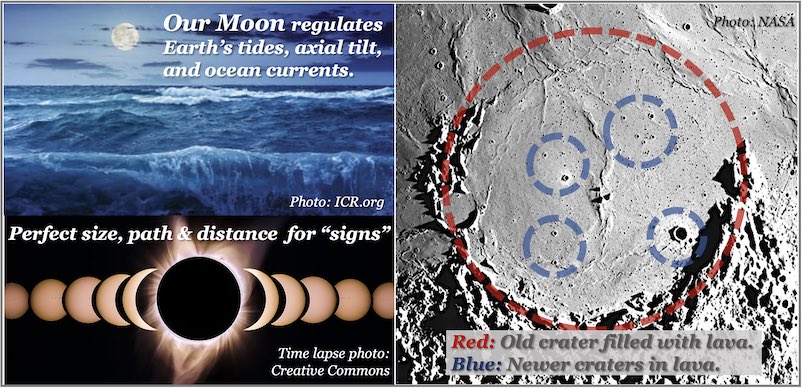Before we leave Earth to explore the other planets, let’s stop and consider our nearest heavenly body, the Moon. It supports Earth’s rotation and orbit by maintaining a 23-½ degree tilt, perfect for stable weather. Lunar tides circulate ocean water, propel ocean currents, clean our oceans, and prevent extreme climate swings. It’s just the right distance from us: too close, and tides would be devastating; too far away, and the Earth would wobble so much that some species would go extinct!
God made our Moon as the lesser light to rule the night, and for signs and for seasons. The Moon is 400x smaller than the Sun, but the Sun is 400x further away. Its path synchronizes with our rotation so one side always faces us. These combine to form unique solar eclipses that enable us to study the Sun’s atmosphere. There’s 163 moons orbiting other planets in our solar system, but none produce eclipses like ours. In fact, ours is closer than most other planetary moons. [1]
Any telescopic view shows plenty of craters on Moon’s surface. With an undisturbed surface due to its windless atmosphere, we have a pristine environment to study them. Evolution believes all craters form slowly, but the evidence is clear that cratering rates were much higher in the past than today. Consider ghost craters, older impacts now filled in by lava (see red circle). They often have empty craters inside of them (see blue circles). Since lava cools quickly on the moon, this means some asteroids splashed into the hot lava before it quickly solidified, arguing for a younger universe than evolution holds.
Researchers claim we got our Moon via the capture theory; as it flew by, Earth’s gravitational field pulled it into orbit. But planetary capture is exceeding rare; it would either hit us, fly by, or swing into an elliptical orbit. Others say a Mars-sized asteroid hit the Earth, splitting into two bodies. [2] (Hard to imagine a collision producing two nearly perfect spheres!) NASA collected lunar rocks on Apollo 15 and 17 in part to seek support for this theory. A creation scientist writing on the investigation reports that [r]emarkably, the isotope ratios of oxygen, iron, hydrogen, silica, magnesium, titanium, potassium, tungsten and chromium are almost identical in moon and Earth rocks. At the same time, they are different from other solar system bodies. This is such a problem for the impact theory that, according to some researchers, it is now in crisis. [3] NASA also found some water in the moon soil samples, which should have been vaporized by any such collision.
Evolution’s impact theory also reasons that the Moon cooled much faster than Earth because it’s smaller; in fact, by now it should be hard and solid. But since the 1500’s we have records of flashes and temporary glows of light from volcanic vents, meaning it’s geologically active. Apollo 15 measured radon gas coming from a crater, which should have boiled away ages ago. The 2011 Lunar Reconnaissance Orbiter revealed volcanic activity made of viscous silica rocks on the dark (colder) side of the moon. Undaunted by these facts, researchers offered wild explanations to preserve their theory, instead of rightly concluding the Moon can only be a few thousand years old at most. [4]
Evolution can’t explain its origin, orbit, or its geological activity. Creation can, because the moon [is] a faithful witness in heaven to the God who made it on the fourth day to satisfy His purposes.
[1] Dr. Jerry Bergman, The Moon: Required for Life on Earth, ICR, Sept. 2018
[2] Spike Psarris, “What You Aren’t Being Told About Astronomy: Our Created Solar System”, Creation Astronomy DVD, 2009
[3] Dominic Statham, The Mystery of the Moon, Creation Ministries Int’l, Oct. 2018
[4] Emil Silvestru, The not-so-dark side of the Moon, Creation Ministries International, Aug. 2011
Like this? Consider sharing it to Facebook by clicking the linked icon below.
